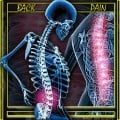Prevent Back Injury Using Proper Body Mechanics
Back Pain
Back injuries are debilitating and restrictive. Whether acute or chronic, back pain causes distress and frustration to the person experiencing it. The ability to move freely is taken for granted by most people. Back injuries take away your freedom of movement...and sometimes your freedom to sit, stand, lie...without pain.
Numerous people experience back injuries every year. Over 600,000 people had back injuries in the USA during 1991. Many professions are at risk for back injuries. People who do repetitive lifting are at higher risk for back injuries. Certain jobs such as construction workers, postal workers, warehouse workers and farmers come to mind when one thinks of repetitive lifting. However, the profession that experiences the most back injuries of all is nursing.
Risk Factors for Back Injury
Aging is a risk factor for back injury. As the body ages it loses strength and coordination, joints tighten and lose flexibility, and balance deteriorates. Lean muscle mass begins to be replaced by adipose tissue. The shock absorbers of the spine, known as discs, begin to thin and compress. I tell my kids it is because of the weight of the world has been on my shoulders all these years. These are the reasons we grow shorter with age and these are the reasons the risk of back injury increases.
Previous back injury increases the risk of new back injury. The repeated wear and tear on the spinal column increases the risk of injury. If you have injured your back in the past, you have had greater than normal wear and tear. Therefore, you have greater than normal risk for new re-injuring the same area.
Occupations that require repetitive lifting and bending and are physically demanding also carry a higher risk of back injury. Some of the greatest risks for back injury are repetitive lifting, bending and lifting, pushing and pulling of heavy items. These actions increase the strain on the spinal column and the spinal discs.
A sedentary lifestyle may lead to back injury. Failure to keep moving makes moving harder than ever. Weak abdominal muscles and being overweight increases the strain on the back. This increased strain makes even easy tasks difficult for your back increasing the risk of back injury.
Poor posture will increase your risk of back injury. I heard on the radio a couple of days ago that having your shoulders located in front of your hips will cause you many problems. Slouching in your chair, driving hunched over and standing incorrectly causes misalignment of your spine and increases your risk for back injury.
Body Mechanics and Posture
Body mechanics encompass coordinated muscle movement to maintain correct posture, prevent injury and enhance physical endurance. The use of proper body mechanics during daily tasks, especially tasks involving lifting or moving heavy objects, prevents injury to the back. By coordinating your muscles, you prevent undue strain on any one muscle or joint.
Your spine, when correctly aligned, has natural curves that keep the head centered over the hips. You should be able to draw an invisible line from your earlobe, through your shoulders, then hips, then knees, ending up in the middle of your ankle when you are standing utilizing good posture. Correct spinal alignment is essential to preventing back injury.
To maintain good posture you should keep your head up and your chin in; keeping your back flat, pull your abdomen in and up while tucking your buttocks. This will help your spine align correctly. When standing you should feel as if your weight is forward and supported on the outsides of your feet.
The Golden Rule of Body Mechanics
Correct posture is the first rule of proper body mechanics. You should always maintain good posture. You will also need a stable center of gravity. The body's center of gravity is found just over the pelvis. This is the point that the entire weight is balanced. Think of a seesaw, the center of the seesaw is the center of gravity for the seesaw. You can balance the seesaw horizontally on this point.
The inward curve in the lower spine allows a stable center of gravity while standing upright. This is one reason why it is so important to maintain good posture. Because the human body is not symmetrical, the center of gravity changes with movement. Therefore you need to have a stable base also.
A wide base of support is the most stable kind. Your base of support when standing are your feet. It is more difficult to keep your balance when you stand with your feet together as opposed to standing with your feet apart. A wider base of support distributes the weight evenly over a greater area. An imaginary line should be able to be drawn from your center of gravity to the middle of your base of support. This is the line of gravity.
The line of gravity should pass vertically through your center of gravity and base of support to maintain balance. When you lift something it changes your center of gravity and your line of gravity. Keeping the item close to your body will maintain the line of gravity within your base of support.
Tips For Good Posture
Using Proper Body Mechanics to Lift
When you lift an object, ensure your feet are at least as far apart as your shoulders. A little further apart is also good as it gives you a wider base of support. Have one foot slightly in front of the other for balance. Face forward and maintain good body posture. Use the strong muscles of your legs to lift. Bend at the hips and knees, not at the waist. Keep your back straight. Keep the object you are lifting close to the body. Lift in one smooth motion. If you need to turn, turn with your feet, do not twist your body.
If you need to lift an object from the floor to shoulder height, place it on a table at about waist height to shift your grip. It is best to store heavy items at waist height and lighter items on higher and lower shelves. This will prevent the need to lift heavy items overhead which can cause excessive stress to the back.
Rules For Safe Lifting
Using Proper Body Mechanics to Push and Pull
Always push an items if possible. Pushing uses the strong muscles of the legs and hips, while pulling tends to use the muscles of the back. Use your weight to push, lean into the item, bending at the hips and knees and keeping your back straight. Lean away from the item when pulling, using your body weight to assist you. Once the item has started moving, keep it in motion. Objects are easier to keep in motion once started. Jerking the object, or starting and stopping movement is more difficult and causes more stress to the back.
Whenever possible use mechanical devices to help push or pull an item. Place the item on a cart or dolly using proper lifting techniques. Reducing the friction required to move an object makes it easier to move. Always try to think of a way to push, not pull, an item.
Push vs Pull
Exercises for a Healthy Back
This content is for informational purposes only and does not substitute for formal and individualized diagnosis, prognosis, treatment, prescription, and/or dietary advice from a licensed medical professional. Do not stop or alter your current course of treatment. If pregnant or nursing, consult with a qualified provider on an individual basis. Seek immediate help if you are experiencing a medical emergency.
© 2009 Kari Poulsen



